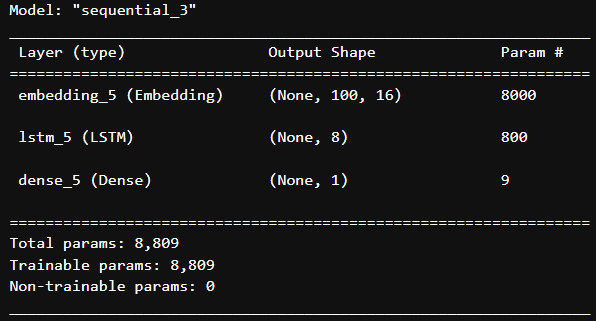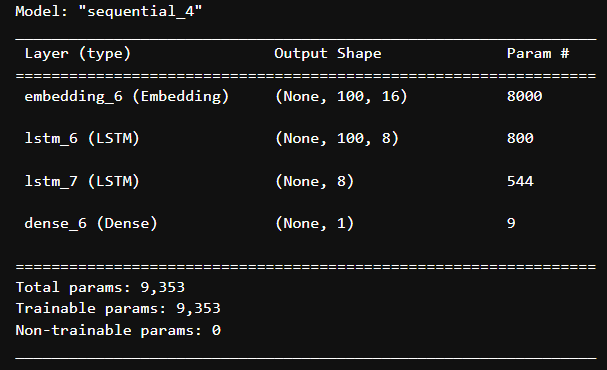| 일 | 월 | 화 | 수 | 목 | 금 | 토 |
|---|---|---|---|---|---|---|
| 1 | ||||||
| 2 | 3 | 4 | 5 | 6 | 7 | 8 |
| 9 | 10 | 11 | 12 | 13 | 14 | 15 |
| 16 | 17 | 18 | 19 | 20 | 21 | 22 |
| 23 | 24 | 25 | 26 | 27 | 28 | 29 |
| 30 |
- 오라클
- 파싱 오류
- 시각화
- 예측
- 데이터
- 훈련
- 데이터전처리
- 머신러닝
- 데이터 분석
- tensorflow
- Deep Learning
- 정확도
- MariaDB
- HeidiSQL
- python기초
- 데이터 수집
- Database
- Oracle
- 회귀모델
- keras
- 딥러닝
- 데이터 가공
- 데이터베이스
- pythone
- DB
- python
- sklearn
- sql
- pandas
- 해석
- Today
- Total
코딩헤딩
Deep learning[딥러닝] LSTM GRU 본문
<simple RNN 단점>
- 긴 문장(시퀀스)을 학습하기 어려움
- 시퀀스가 길 수록 초반의 정보는 점진적으로 희석(소멸)
즉, 멀리 떨어져 있는 단어의 정보를 인식하는데 어려움이 있음.
- 이러한 단점을 보완한 모델이 LSTM과 GRU
<LSTM(Long Shot - Term Memory; 장기기억)>
- 단기기억을 오래 기억할 수 있도록 고안된 모델
- 많은 이전 정보를 기억해야 하기 때문에 훈련속도가 느리며, 시스템 저장 공간이 많이 필요함
<GRU(Gated Reccurent Units; 게이트 반복 단위)>
- LSTM의 느린 속도를 개선하기 위해 고안된 모델
- 성능은 LSTM과 유사함
** SimpleRNN, SLTM, GRU 모두 RMSprop 옵티마이저를 일반적으로 사용함.
* 사용 라이브러리 정의
import tensorflow as tf
from tensorflow import keras
### 영화 감상평에 대한 긍정/부정 데이터셋
from tensorflow.keras.datasets import imdb
from sklearn.model_selection import train_test_split
### 텍스트 정규화 (길이 맞추기)
from tensorflow.keras.preprocessing.sequence import pad_sequences
* 사용할 데이터 : IMDB
(train_input, train_target), (test_input, test_target) = imdb.load_data(num_words=500)
print(train_input.shape, train_target.shape)
print(test_input.shape, test_target.shape)결과 :
(25000,) (25000,)
(25000,) (25000,)
- IMDB데이터 사용, 말뭉치 500개 사용
* 훈련 : 검증 데이터로 분류하기 2 : 8
train_input, val_input, train_target, val_target = train_test_split(train_input, train_target,
test_size=0.2, random_state=42)
print(train_input.shape, train_target.shape)
print(val_input.shape, val_target.shape)
print(test_input.shape, test_target.shape)결과 :
(20000,) (20000,)
(5000,) (5000,)
(25000,) (25000,)
- train : val =8 : 2로 분류하기
* 택스트 정규화 하기
train_seq = pad_sequences(train_input, maxlen=100)
val_seq = pad_sequences(val_input, maxlen=100)
test_seq = pad_sequences(test_input, maxlen=100)
print(train_seq.shape, train_target.shape)
print(val_seq.shape, val_target.shape)
print(test_seq.shape, test_target.shape)결과 :
(20000, 100) (20000,)
(5000, 100) (5000,)
(25000, 100) (25000,)
- 훈련, 검증, 테스트 데이터 내에 각 문장의 길이를 100으로 통일(정규화) 시키기
* LSTM모델 훈련
* 모델 생성하기
model = keras.Sequential()
model
* 계층 생성 및 모델에 추가하기
model.add(keras.layers.Embedding(500, 16, input_length=(100)))
model.add(keras.layers.LSTM(8))
model.add(keras.layers.Dense(1, activation="sigmoid"))
model.summary()
- 임베딩 계층 추가 : 말뭉치 500개,
출력크기 16, 입력크기 100
- LSTM 계층 추가 : 출력크기 8
- 출력 계층 추가
* 모델 설정하기
rmsprop = keras.optimizers.RMSprop(learning_rate=0.0001)
model.compile(optimizer=rmsprop,
loss="binary_crossentropy",
metrics=["accuracy"])
* 콜백함수 만들기
model_path = "./mdoel/best_LSTM_model.h5"
checkpoint_cb = keras.callbacks.ModelCheckpoint(
model_path,
save_best_only=True
)
early_stopping_cb = keras.callbacks.EarlyStopping(
patience=3,
restore_best_weights=True
)
checkpoint_cb, early_stopping_cb콜백함수 정의하기
- 위치 및 파일명: ./mdoel/best_LSTM_model.h5
- 자동 저장 및 자동종료
* 모델 훈련시키기
history = model.fit(
train_seq, train_target, epochs=100, batch_size=64,
validation_data=(val_seq, val_target),
callbacks=[checkpoint_cb, early_stopping_cb]
)train_eval = model.evaluate(train_seq, train_target)
val_eval = model.evaluate(val_seq, val_target)
test_eval = model.evaluate(test_seq, test_target)결과 :
625/625 [==============================] - 4s 6ms/step - loss: 0.4100 - accuracy: 0.8145
157/157 [==============================] - 1s 5ms/step - loss: 0.4339 - accuracy: 0.7994
782/782 [==============================] - 4s 5ms/step - loss: 0.4286 - accuracy: 0.8013
* LSTM 모델에 드롭아웃 속성(계층 아님) 적용하기
model2.add(keras.layers.Embedding(500, 16, input_length=(100)))
model2.add(keras.layers.LSTM(8, dropout=0.3))
model2.add(keras.layers.Dense(1, activation="sigmoid"))
model2.summary()
- LSTM모델(계층)에 드롭아웃 속성 적용, 30%
훈련에서 제외
- 나머지 모두 위와 동일하게 처리하여 훈련, 점증,
테스트에 대한 성능 검증까지 진행
rmsprop = keras.optimizers.RMSprop(learning_rate=0.0001)
model2.compile(optimizer=rmsprop,
loss="binary_crossentropy",
metrics=["accuracy"])model_path = "./mdoel/best_LSTM_model + drop_out.h5"
checkpoint_cb = keras.callbacks.ModelCheckpoint(
model_path,
save_best_only=True
)
early_stopping_cb = keras.callbacks.EarlyStopping(
patience=3,
restore_best_weights=True
)
checkpoint_cb, early_stopping_cb결과 :
(<keras.callbacks.ModelCheckpoint at 0x1c1bedccdc0>,
<keras.callbacks.EarlyStopping at 0x1c1bedcc9d0>)
* 모델 훈련시키기
history = model2.fit(
train_seq, train_target, epochs=100, batch_size=64,
validation_data=(val_seq, val_target),
callbacks=[checkpoint_cb, early_stopping_cb]
)train_eval = model2.evaluate(train_seq, train_target)
val_eval = model2.evaluate(val_seq, val_target)
test_eval = model2.evaluate(test_seq, test_target)결과 :
625/625 [==============================] - 4s 6ms/step - loss: 0.4100 - accuracy: 0.8163
157/157 [==============================] - 1s 5ms/step - loss: 0.4357 - accuracy: 0.8032
782/782 [==============================] - 4s 5ms/step - loss: 0.4293 - accuracy: 0.8030
<LSTM 2개 연결하기>
- LSTM 2개를 연결할 때는 연속해서 LSTM 계층을 추가해야 함
- 첫 번째, LSTM 계층의 속성에는 return_sequenes=True 속성을 추가해 준다.
- 두 번째, LSTM은 첫 번째 LSTM의 훈련결과를 이어받아서 계속 훈련을 이어나간다.
* 모델 생성
model3 = keras.Sequential()
model3* 계층 추
model3.add(keras.layers.Embedding(500, 16, input_length=(100)))
model3.add(keras.layers.LSTM(8, dropout=0.3, return_sequences=True))
model3.add(keras.layers.LSTM(8, dropout=0.2))
model3.add(keras.layers.Dense(1, activation="sigmoid"))
model3.summary()
* 모델 설정하기
rmsprop = keras.optimizers.RMSprop(learning_rate=0.0001)
model3.compile(optimizer=rmsprop,
loss="binary_crossentropy",
metrics=["accuracy"])* 콜백함수 정의
model_path = "./mdoel/best_LSTM_model + drop_out + 2LSTM.h5"
checkpoint_cb = keras.callbacks.ModelCheckpoint(
model_path,
save_best_only=True
)
early_stopping_cb = keras.callbacks.EarlyStopping(
patience=3,
restore_best_weights=True
)
checkpoint_cb, early_stopping_cb* 모델 훈련
history = model3.fit(
train_seq, train_target, epochs=100, batch_size=64,
validation_data=(val_seq, val_target),
callbacks=[checkpoint_cb, early_stopping_cb]
)* 모델 평가
train_eval = model3.evaluate(train_seq, train_target)
val_eval = model3.evaluate(val_seq, val_target)
test_eval = model3.evaluate(test_seq, test_target)결과 :
625/625 [==============================] - 7s 10ms/step - loss: 0.3999 - accuracy: 0.8188
157/157 [==============================] - 1s 9ms/step - loss: 0.4257 - accuracy: 0.8068
782/782 [==============================] - 7s 9ms/step - loss: 0.4206 - accuracy: 0.8039
'머신러닝 | 딥러닝' 카테고리의 다른 글
| Deep learning[딥러닝] 합성곱신경망(CNN; Convolutional Neural Network) (0) | 2024.01.09 |
|---|---|
| Deep learning[딥러닝] RNN 응용 규칙기반 챗봇 (1) | 2024.01.09 |
| Deep learning[딥러닝] 심플순환신경망(simple RNN) (1) | 2024.01.08 |
| Deep learning[딥러닝] 퍼셉트론(Perceptron) (0) | 2024.01.06 |
| Deep learning[딥러닝] 모델 생성 함수 및 손실률/정확도 시각화 (0) | 2024.01.05 |




